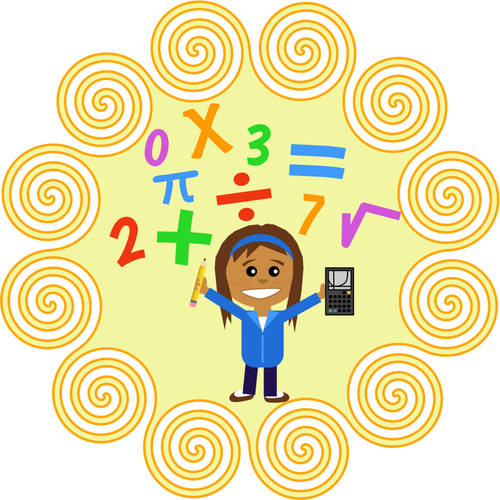I wrote about struggles I’ve always had with reading before, but I’ve never really reflected on my struggles with Math. Reading is more prevalent so I face my struggles on a daily basis. My struggles with Math are not as obvious, especially because the types of Math I use daily are Maths I can do easily and quickly. Plus I’ve always taught 4th through 6th grade Math, which I can do.
Yes, I’m a teacher and I have struggles with reading and with the doing of Math. We can still do our jobs very well, and sometimes better because we can relate due to our deficits. No one is perfect. During the summer of 2013 I took an online course from Jo Boaler on How People Learn Math, which was amazing, but I had not taught Math from 2005 to 2021 so I did not get to use the ideas I learned! To curate my learning I wrote a series of 10 blog posts that I referred to when I taught Math again last year, 2021-22. After so many years not teaching Math and having zero familiarity much less training with the Common Core Math Standards, the 10 blog posts I wrote were just not enough. The ideas were great and just what I needed but something was missing. The how. I didn’t know HOW to put the ideas I learned into action. What made that difficult for me was that I was taught Math by using algorithms without understanding why or how those algorithms worked. I am one of those people who can do what my teachers showed me but when having to apply that knowledge I stumbled. If new problems differed from what I was shown, I didn’t always solve them correctly. And using Math in real life, not so much, especially not the Math I learned in school! It was not easy for me to apply the Math I learned in school to real life. So when I prepped for my 21-22 5th and 6th grade Math classes, I was fine with the 6th grade curriculum – Big Ideas – because it used all the algorithms I learned in school! For 5th grade, we use Bridges. The curriculum was daunting with so many binders that the sheer amount of reading material was more than I could handle in a few weeks. Also, Bridges didn’t use any of the algorithms I learned in school! I didn’t get professional development for the new Bridges curriculum until the end of January so I used free curriculum from Jo Boaler’s website, YouCubed, because I knew she provided excellent Math curricula.
By the end of the 21-22 school year I knew that I needed more training in Math because I could do better. I went to my Twitter PLN for ideas for Math PD and they did not disappoint! Here’s the Twitter thread with all the amazing resources people shared. I attended the MCMI Math Institute 2022. It was great and there was a session on using Desmos, which I have been really interested in learning more about. The other resource I really want to learn more about is Mathigon so the next time a Mathigon workshop is offered I need to catch it!
Aside from the really good Math Institute and the resources I want to learn more about (Desmos and Mathigon), I found that two of the resources shared on Twitter were above and beyond the most amazing PD and just what I needed! I am not exaggerating when I say that two resources I’m sharing here are the most amazing PD – I mean it. In my 31 years teaching I have been through PD every year and every summer without a miss and what I’m sharing here is literally the best I’ve seen so far for a Math teacher looking to improve their Math education and educating. I’ve learned about the proper way to teach Maths. I’ve listened to amazing and inspiring keynotes, I’ve taken a Jo Boaler’s Stanford online course on How People Learn Math, and I’ve had glimpses of how to teach Math but always something was missing. Concrete strategies were missing. There was one year I taught Math at my school when we adopted the Connected Mathematics Project (CMP) and that curriculum was structured the way Maths should be taught. Sadly, that curriculum didn’t last long because teachers didn’t have the proper training to implement it the way it should be implemented. I only taught one year with CMP and that was the last year I taught Math, 2004-05.
The brief work I did this past school year with our Math consultant, I see that the Bridges curriculum is also structured in line with how kids can and will learn Math. But there were still two missing pieces – training and my own lousy Math education. I know there will never be enough training – lack of funds and time are challenges that need to be overcome and are seemingly insurmountable. Also, Bridges is so dense and there is so much that it’s a struggle to know where to focus so like CMP, follow-up training is needed for those teachers who received the initial training and especially for those of us who taught it for the first time with little to no training. So we have good curriculum but that alone is not enough, especially for those of us who were taught Math incorrectly. I didn’t have any other strategies for doing Math so when teaching CMP or Bridges, I needed to learn along with my kids!
The first resource I tried was a free online course and it not only revealed what I’ve always known, that the way I was taught Math is not the way Math should be taught but also showed me HOW TO FIX THAT. From my own Math education, I learned how to mimic the teachers and I can use enough of the algorithms I mimicked to do enough Math to be competent, but my lack of conceptual understanding continues to hold me back and slow me down as I catch up to what I need to know to make sense of curricula like CMP and Bridges.
This free online workshop by Pam Harris was the missing link in what I needed to best help kids learn Math and Pam is one of the authors of the K-5 Bridges Math curriculum! Honestly, her free workshop alone is the BEST Math training I have gotten in my 31 years of teaching. Hands down.
The free online course, which is only the tip of the iceberg (further workshops are not free of course) goes with the following book and even though the book is labeled for middle school and high school teachers there is plenty there for primary and elementary teachers because there are problem strings for everything from counting strategies and additive thinking taught in the primary grades, which btw many of our kids are still utilizing, all the way to functional reasoning needed in high school:
I am reading through Pam’s book along with the Lessons and Activities book with problem strings that I can use with my students, and I am going through her many podcasts as I prepare to teach Math better than ever starting this fall!
Another resource I tried out that came recommended from multiple people on Twitter, is Peter Liljedahl’s Building Thinking Classrooms:
And Building Thinking Classrooms seems to work perfectly with Pam’s Building Powerful Numeracy!! To add to the amazing learning I’m doing through Pam’s books and resources, she’s quite active on Twitter and Facebook, Building Thinking Classrooms shows teachers how to help ALL our students become actively involved in their own learning of Math! Building Thinking Classrooms has the following Facebook group where educators share strategies as well as tips and answer each other’s questions plus they have regular chats and meetings to go over how to adopt the different strategies and it costs nothing! That has proven to be the amazing support and follow-up that we need as we learn new curriculum, or more importantly, better ways to teach Mathematics! That Facebook group is the best I’ve participated in! Teachers are very active on there, very helpful, chats are offered and recorded, and all the resources shared and created are saved and accessible right on the group page! And did I mention that it’s all free (except for buying the book of course).
And what’s more both Pam’s workshops and podcasts and Peter’s Building Thinking Classrooms continues to pop up in Math circles including the MCMI Math Institute I just virtually attended! Boom!










































































